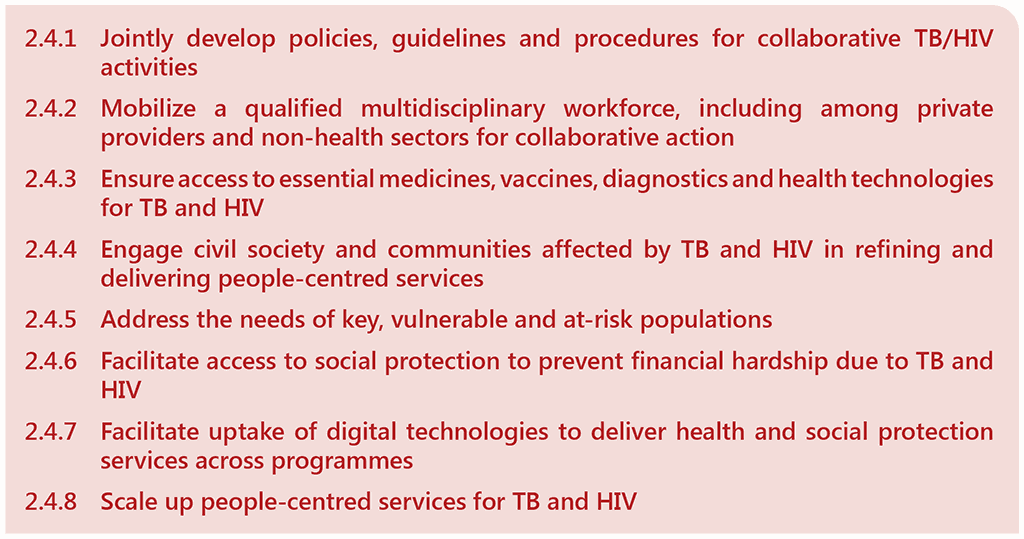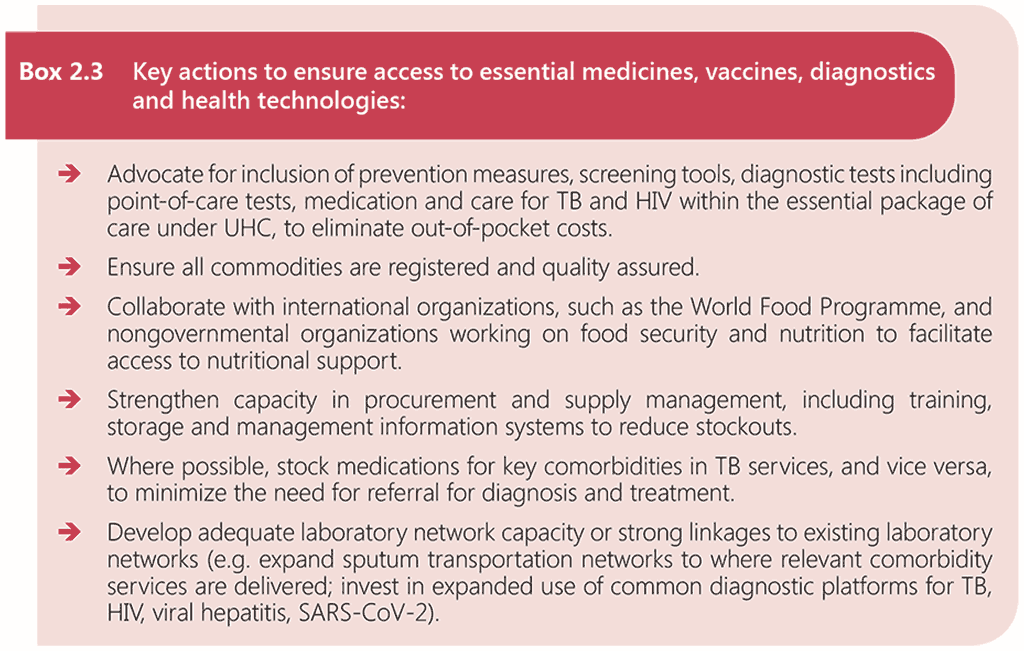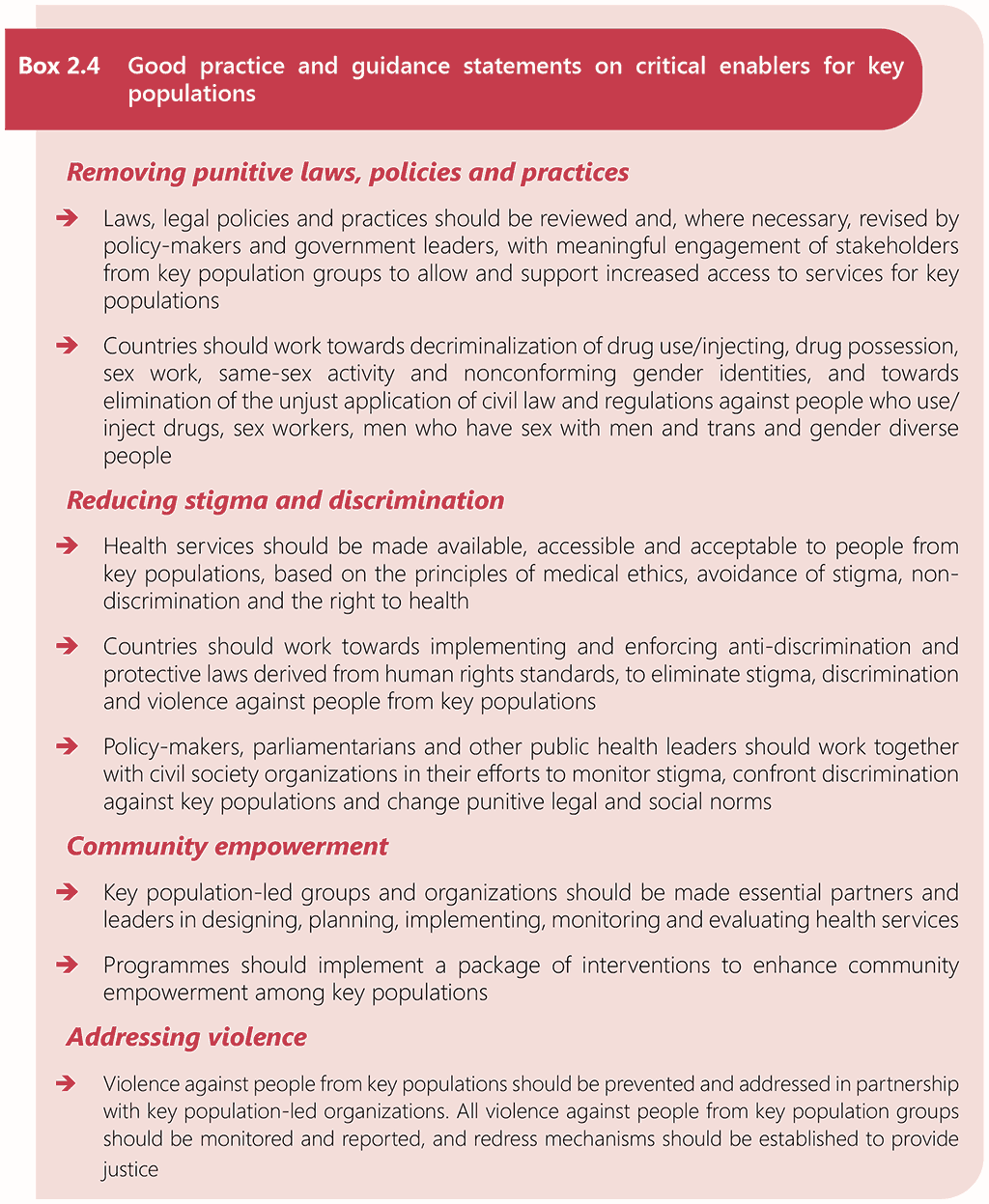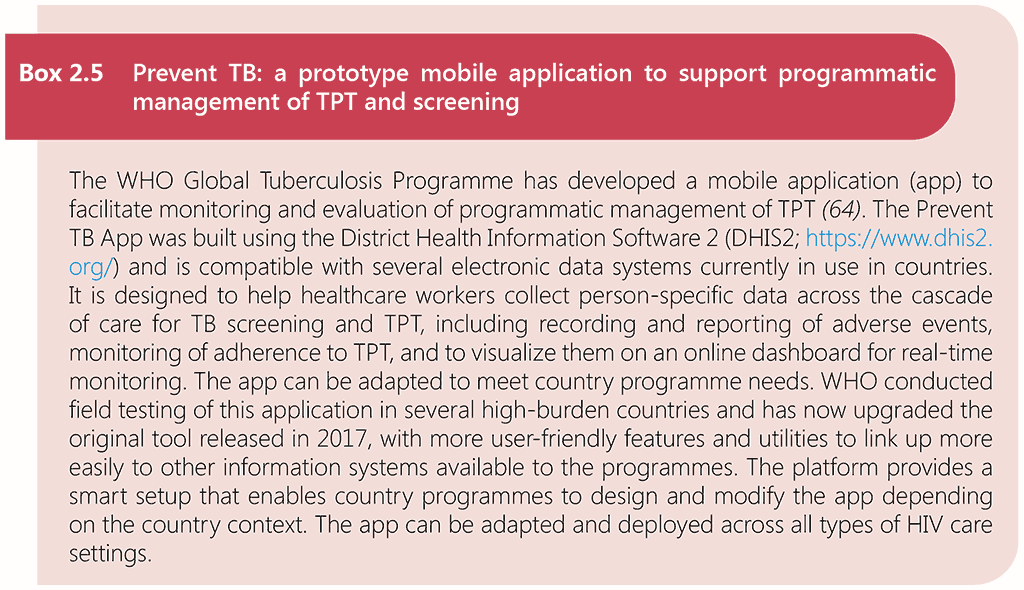Book traversal links for 2.4 Implement and scale up people-centred services for HIV-associated TB

2.4.1 Jointly develop policies, guidelines and procedures for collaborative TB/HIV activities
To implement and scale up people-centred services for TB and HIV, programmes should jointly develop policies, guidelines and procedures for collaborative action and mainstream collaborative TB/HIV activities within national guidelines and standard operating procedures. Consideration should also be given to assessing and addressing other common comorbidities and risk factors such as under-nutrition, pulmonary disorders other than TB, mental illness, tobacco use, substance use disorders and diabetes.
2.4.2 Mobilize a qualified multidisciplinary workforce, including among private providers and non-health sectors for collaborative action
An adequately trained multidisciplinary workforce should be mobilized according to needs identified. Joint capacity-building for collaborative activities should include training of TB, HIV and primary healthcare workers in issues related to HIV-associated TB. Consideration should also be given to the role of the private sector and medical associations in increasing capacity and resources (32). Ensuring continued competency-based education of healthcare workers through clinical mentoring, regular supportive supervision and the availability of standard operating procedures and job aids, reference materials and up-to-date national guidelines is important (7).
2.4.3 Ensure access to essential medicines, vaccines, diagnostics and health technologies for TB and HIV
Countries should ensure access to essential medicines, vaccines, diagnostics and health technologies as required in the respective services, according to the models of care for delivering integrated services for HIV-associated TB. Capacity should also be enhanced in the healthcare system, for example in the laboratory, supply management, health information, referral and integrated service delivery systems, to enable them to deliver collaborative TB/HIV activities (46). Box 2.3 outlines key considerations to ensure delivery of integrated services for HIV-associated TB.

2.4.4 Engage civil society and communities affected by TB and HIV in refining and delivering people-centred services
Persons affected by or at risk of HIV-associated TB, their communities and civil society should be actively engaged in decision-making, defining needs, prioritizing actions, designing and implementing interventions to address HIV-associated TB and comorbidities, in research as well as in monitoring, evaluating and reviewing their impact (22). They are also important partners in generating demand for integrated services, monitoring and addressing stigma and discrimination and other forms of social exclusion, as well as in delivering health education, advocacy and peer support for those undergoing treatment, for key populations and for the wider community (3). Community health workers should be remunerated according to the scope of their engagement, in line with local employment rules and regulations (47). Advocacy targeted at influencing policy and sustaining political commitment, programme implementation and resource mobilization is very important to accelerate the implementation of collaborative TB/HIV activities (7).
Services for TB prevention, diagnosis, treatment and care can be integrated with those for HIV, and vice versa, through community-based organizations such as TB care or home-based HIV care, and community-based social support. Trained home-based care and community health workers as well as nongovernmental organizations have been successful in providing TB and HIV services in various countries, including for key populations (48-53). Community-based TB (54, 55) and HIV care services (56) are cost effective. While implementing collaborative TB/HIV activities, it is imperative that civil society organizations, including nongovernmental and community-based organizations, advocate, promote and follow national TB and HIV guidelines, including monitoring and evaluation of TB/HIV activities using nationally recommended indicators.
2.4.5 Address the needs of key, vulnerable and at-risk populations

Key populations for HIV are defined groups who are at increased risk of HIV, irrespective of the epidemic type or local context (57). The five key populations as defined by WHO are 1) men who have sex with men; 2) people who inject drugs; 3) people in prisons and other closed settings; 4) sex workers; and 5) trans and gender diverse people (57). Due to the increased risk of HIV, members of key population groups are also at significant risk of HIV-associated TB. In addition, members of some key populations, in particular people who use drugs and people in prisons and other closed settings, are also at elevated risk of TB, regardless of HIV status (58, 59). However, whilst the evidence is limited, men who have sex with men, sex workers and trans and gender diverse people may also be at elevated risk of TB disease, depending on the setting. This would be due to the overlapping social vulnerabilities that drive the TB epidemic.
Multiple social, legal and structural factors both increase vulnerability to HIV and TB, and impede access to health and other essential services. These structural barriers include laws and policies that criminalize drug use or possession, sex work and diverse forms of gender expression and sexuality; stigma and discrimination; lack of community empowerment; and violence. WHO’s Consolidated guidelines on HIV, viral hepatitis and STI prevention, diagnosis, treatment and care for key populations (57) outlines critical enablers that are central to addressing structural barriers and implementing comprehensive services for HIV care for key populations in all epidemic contexts, as shown in Box 2.4. These are also pertinent to populations at risk of TB, regardless of HIV status.
2.4.6 Facilitate access to social protection to prevent financial hardship due to TB and HIV
Although TB and HIV services are generally free of charge, services for TB and HIV often incur costs at the point-of-care (60-62). In addition, there may be high costs related to accessing services for TB and HIV, such as transport costs and income loss, particularly if these services are not delivered at the same time and place (63). Access to social protection interventions, including nutritional support, may help prevent financial hardship across the cascade of care, and prevention of HIVassociated TB. This would also contribute to reducing the impact of social determinants on the TB and HIV epidemics.
2.4.7 Facilitate uptake of digital technologies to deliver health and social protection services across programmes
Countries should harness digital technologies to support the scale-up of TB/HIV collaborative activities. Such technologies may include telemedicine appointments, remote adherence support, video-supported TB treatment and digital data collection tools. Box 2.5 describes the use of a mobile application to support scale-up of tuberculosis preventive treatment (TPT).

2.4.8 Scale up people-centred services for TB and HIV
In many countries, collaborative TB/HIV activities are scaled up nationally. However, in some countries, for example with a concentrated HIV epidemic, access to integrated services for HIVassociated TB can be limited at subnational level. Countries should strive to ensure national coverage of collaborative TB/HIV activities. Scale-up should be informed by ongoing monitoring, review and prioritization. Approaches to scale-up include, for example, by geographical region, such as starting in one or two districts with phased nationwide decentralization at the community level, or through the various stages of care such as starting with screening in the respective services, then gradually scaling up to provide the full cascade of care for TB and HIV in the same facility.
 Feedback
Feedback